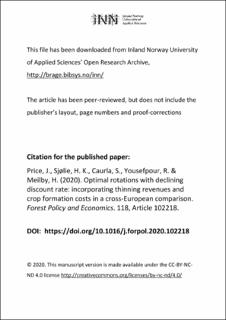| dc.contributor.author | Price, Colin | |
| dc.contributor.author | Sjølie, Hanne Kathrine | |
| dc.contributor.author | Caurla, Sylvain | |
| dc.contributor.author | Yousefpour, Rasoul | |
| dc.contributor.author | Meilby, Henrik | |
| dc.date.accessioned | 2023-02-09T14:28:33Z | |
| dc.date.available | 2023-02-09T14:28:33Z | |
| dc.date.created | 2020-09-10T13:46:24Z | |
| dc.date.issued | 2020 | |
| dc.identifier.citation | Forest Policy and Economics. 2020, 118. | en_US |
| dc.identifier.issn | 1389-9341 | |
| dc.identifier.uri | https://hdl.handle.net/11250/3049819 | |
| dc.description.abstract | Schedules of declining discount rates have been advocated, and adopted by several European governments. They undermine classical solutions to forest economics problems, especially optimal rotation. Adapting classical first-order conditions created problems of local optimisation. A global search algorithm allowed inclusion of initial costs and thinning revenues. It produced results according with expectations – lengthening rotations as time progressed – and results paralleling those for constant discount rates – shorter rotations for high productivity and unthinned crops, and with zero crop formation costs. Apparent anomalies in the pattern of rotations are the due result of opportunity costs from later rotations, which increase as discount rate declines. Sometimes the solution oscillates, usually owing to steps in the discount schedule or irregular profile of felling revenues. Inspection allows the most profitable result to be identified. | en_US |
| dc.language.iso | eng | en_US |
| dc.rights | Attribution-NonCommercial-NoDerivatives 4.0 Internasjonal | * |
| dc.rights.uri | http://creativecommons.org/licenses/by-nc-nd/4.0/deed.no | * |
| dc.subject | declining discount rate | en_US |
| dc.subject | optimal forest rotation | en_US |
| dc.subject | intermediate cash flows | en_US |
| dc.title | Optimal rotations with declining discount rate: incorporating thinning revenues and crop formation costs in a cross-European comparison | en_US |
| dc.type | Peer reviewed | en_US |
| dc.type | Journal article | en_US |
| dc.description.version | acceptedVersion | en_US |
| dc.subject.nsi | VDP::Matematikk og Naturvitenskap: 400::Zoologiske og botaniske fag: 480 | en_US |
| dc.subject.nsi | VDP::Samfunnsvitenskap: 200::Økonomi: 210 | en_US |
| dc.source.pagenumber | 8 | en_US |
| dc.source.volume | 118 | en_US |
| dc.source.journal | Forest Policy and Economics | en_US |
| dc.identifier.doi | 10.1016/j.forpol.2020.102218 | |
| dc.identifier.cristin | 1828761 | |
| cristin.ispublished | true | |
| cristin.fulltext | postprint | |
| cristin.qualitycode | 1 | |

